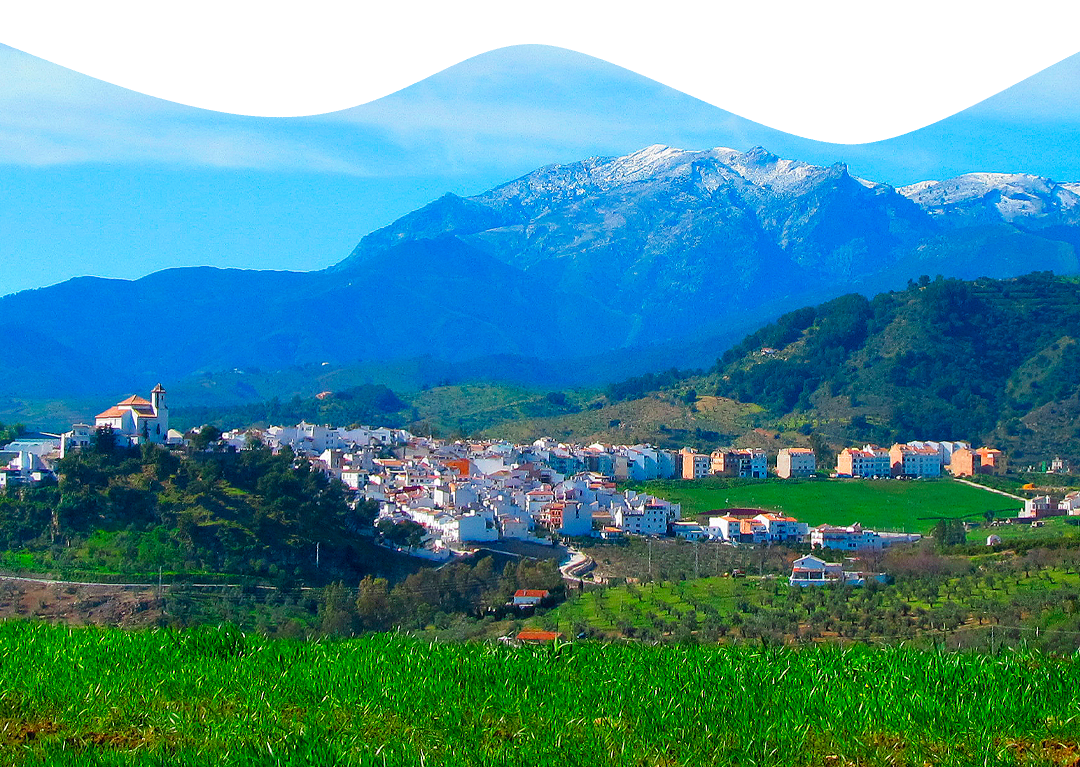


In the year 1570, some 600 men led by El Yebali and Lorenzo Alfaqui from the lands of Ronda disguised themselves as Castilians and arrived at Alozaina with the intention of taking over it, a land where only women, old people and children were found, since their inhabitants had gone to the harvest.
As the story goes, there were only 7 men left, led by Ginés Martín. They managed to break through the ranks of the rioters, along with the women and children disguised with the men's capes, capes and capes, pretending that there was a large garrison, a plan that helped them withstand 3 assaults, although they suffered several casualties.
In the third assault, the Moors fired mercilessly against the castle, seriously wounding the old man. Martin Sagredo (or Lagredo) Domínguez.
Maria Sagredo, seeing his father's blood on the ground, He decided to climb the tower and defend the fortress fiercely., throwing beehives at the enemy and giving the lead to the neighbors, who returned to the attack and managed to remove the enemy from the lands of Alozaina.
SEE HOW IT HAPPENED
The intelligence that was applied when deceiving the Morisco troops, and the incredible courage emanated by María Sagredo when defending the town of Alozaina, are words that are felt in the air of the Torreón.
The attempt cost the Moors seventeen dead and sixty wounded. María Sagredo, seeing her father wounded, made her way through the horde, climbed to the top of a tower that she bravely defended and killed a Moor and wounded others with arrows, lying them at the foot of the tower she was defending. The Moriscos, seeing the resistance and tenacity of those people willing to die rather than surrender, decided to retreat, setting fire to thirty houses, arresting four girls and stealing 3000 heads of cattle.

Click play NOW
He Alozaina arch It is a Mudejar style construction, dating back to the 15th century and was built as the main entrance to the walled area of the town. It is a semicircular arch, built with brick and topped by a belfry.
For a long time, the Alozaina arch has been a symbol of the town's identity and history. At the time, this arch was an example of the power and importance of Alozaina in the region, since it was one of the most important entrances to the town complex.
The Plaza de la Constitución is a square with a long history dating back to medieval times. In its beginnings, this square was known as the "Plaza de la Iglesia", since it was located next to the church of Nuestra Señora de la Encarnación, which is one of the oldest and most emblematic buildings in Alozaina.
For centuries, the square was the nerve center of the town's social and cultural life, being the place where fairs, religious festivals and the most important events in the town were held. In the 19th century, with the arrival of the Spanish Constitution of 1812, the square changed its name to "Plaza de la Constitución", in honor of this historical event.
In the 20th century, the Plaza de la Constitución became a meeting and coexistence place for the inhabitants of Alozaina, and some of the most important buildings in the square were built, such as the Town Hall and the House of Culture. During the Spanish Civil War, the square witnessed some of the harshest and most tragic episodes in the history of Alozaina, and many of its buildings suffered serious damage.
After the war, Constitution Square was rebuilt and restored, maintaining much of its charm and history. Currently, it is one of the most beloved and emblematic places in Alozaina, and continues to be the scene of numerous events and festivities that bring together the town's inhabitants and visitors.
St. Anne's Church It is the main parish of Alozaina, located in the square of the same name in the historic center of the town. It is a Mudejar-style religious building, built in the 16th century on an old mosque.
The church has a single nave, with a barrel vault and a semicircular apse, typical of the Mudejar style. The bell tower, located on the right side of the temple, is baroque in style and has four sections and a dome.
The interior of the church is in Renaissance style, with some works of art and architectural elements of great value. Highlights include the main altarpiece, in baroque style, which houses an image of Saint Anne, patron saint of the town, and the marble baptismal font, from the 18th century.
The church of Santa Ana is a place of great religious importance for the inhabitants of Alozaina, and is the scene of numerous religious events and celebrations throughout the year.
Discover the Parish Church of Santa Ana
The tower It was built in the 13th century by the Sagredo family, an important noble family of the time, to protect their residence and property. The building has three floors and a roof terrace, and is located in the historic center of the town, on the street of the same name.
Over the centuries, the keep has been used for various purposes. In the Middle Ages, it was used as a fortress to protect the property of the Sagredo family. Later, it was used as a prison and, later, as a warehouse for oil and wine.
Currently, the Torreón de María Sagredo is a protected monument and is used as a cultural center, where exhibitions, conferences and other cultural events are organized. The tower also has a small garden at its base, where you can find some archaeological remains from medieval times.
Discover the Torreón de María Sagredo
The Hornacina Cruz Villa de Alozaina is a small chapel located on Cruz Villa street, in the historic center of Alozaina. It is a neoclassical style construction that dates back to the 19th century.
The niche houses a carved and polychrome wooden cross, which is the object of great devotion by the inhabitants of Alozaina. The cross is framed by a neoclassical style altarpiece, in which various religious and decorative motifs can be seen.
The niche has undergone various remodeling and restorations throughout its history, but it has always maintained its function as a place of devotion and veneration by the inhabitants of Alozaina. The cross in the niche is considered an important symbol of the town's identity and is the object of great veneration in local religious festivities.
The Mirador de Alozaina Park is a public space located in the upper part of the town, in an elevated area that allows you to enjoy spectacular panoramic views of the surrounding landscape. It is a park with an area of 20,000 square meters, which has a wide variety of green areas, gardens and recreational facilities.
It is a very popular place among the town's inhabitants, who come there to enjoy a day outdoors in contact with nature and with impressive views of the Sierra de las Nieves and the Guadalhorce Valley.
The park is also an ideal starting point for hiking routes around Alozaina, as it has several trails that start from its surroundings.
The cultivation of citrus fruits in Alozaina dates back centuries. The area's oranges are known for their sweet and juicy flavor, and are used both in local cuisine and in the production of juices and jams. The region's Mediterranean climate, with mild winters and hot summers, is perfect for growing citrus fruits.
As for olive trees, the municipality of Alozaina has an important production of high quality olive oil. Olive trees are one of the main crops in the area, and are grown both for own consumption and for marketing. The olive oil produced in the region has an intense flavor and characteristic aroma, and is highly valued for its quality.
These emblematic streets are located in the historic center of the municipality and are one of the oldest streets in the town, highlighting the following:
On Hoya Street, for example, you can find stone and adobe houses with white facades and wrought iron balconies. The roofs are usually made of clay tiles and some of them have interior patios that provide light and ventilation to the rooms.
In Barrio Hondillo, the houses also have white facades and are characterized by having thick walls to protect themselves from heat and extreme temperatures. The houses have small windows and wrought iron balconies overlooking the local landscape. Some houses have interior patios with gardens and fountains that provide coolness in the hottest months.
On Rodahuevos Street, the houses also have white facades and wrought iron balconies overlooking the area's landscape. The houses are smaller than on the other streets, since it is a narrow street that did not allow for the construction of large buildings. Some houses have wooden doors and windows that give a more rustic touch to the architecture of the street.
Alozaina received the 1st National Prize for Beautification of the Towns of Spain in 1977. This prize was awarded by the Ministry of Information and Tourism of Spain in recognition of the municipality's efforts to improve its urban and architectural heritage.
During the 1970s, Alozaina undertook an important process of renovation and improvement of its infrastructure and public services. New streets and squares were built, historic buildings were restored and public lighting and green areas were improved. These improvements contributed to the municipality being awarded the national beautification award.
The national beautification award was created in 1973 with the aim of recognizing the efforts of Spanish municipalities to improve their urban and landscape heritage. The award was awarded annually to municipalities that stood out for their initiatives in urban planning, architecture, heritage conservation and improvement of the quality of life of their inhabitants. Alozaina was one of the first municipalities to receive this award, which represented important recognition for its work to improve and preserve its heritage.